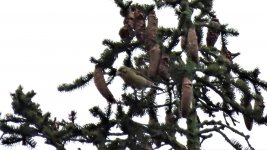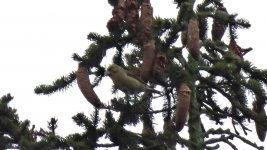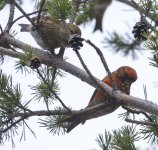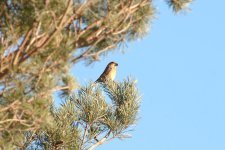-
Welcome to BirdForum, the internet's largest birding community with thousands of members from all over the world. The forums are dedicated to wild birds, birding, binoculars and equipment and all that goes with it.
Please register for an account to take part in the discussions in the forum, post your pictures in the gallery and more.
You are using an out of date browser. It may not display this or other websites correctly.
You should upgrade or use an alternative browser.
You should upgrade or use an alternative browser.
Parrot or red crossbill? Photos from NW Poland, 29.01.2020 (1 Viewer)
- Thread starter Ryszard
- Start date
More options
Who Replied?Andy Adcock
Worst person on Birdforum

I think it must be parrot with a bill that thick
They are variable hence one of the reasons for debate over 'Scotbill' but this bird has that 'bull necked' appearance too.
Nutcracker
Stop Brexit!
I was thinking, despite the apparent thickness of the bill, that the head looked rather small! Also the bill is a bit foreshortened (and blurred, too!), making shape assessment unsafe. So I'm going to err on the side of caution and go for Common Crossbill.
They are variable hence one of the reasons for debate over 'Scotbill' but this bird has that 'bull necked' appearance too.
So for believers in that taxon, bill thickness goes: common <=Scottish <=parrot. From the pics I've seen, this is well to the right of that spectrum. Since "Scottish" isn't recorded from Poland that makes it parrot for me (don't personally believe in Scottish crossbill as a species but I think it an interesting phenomenon if really restricted to Scots pine: a bit like Scottish crested tit or British swallowtail butterfly)
Andy Adcock
Worst person on Birdforum

So for believers in that taxon, bill thickness goes: common <=Scottish <=parrot. From the pics I've seen, this is well to the right of that spectrum. Since "Scottish" isn't recorded from Poland that makes it parrot for me (don't personally believe in Scottish crossbill as a species but I think it an interesting phenomenon if really restricted to Scots pine: a bit like Scottish crested tit or British swallowtail butterfly)
This is one of the problems, I'm not sure they are. Birds fitting the bill measurements which would usually be assigned to Scottish, have been recorderd as far South as Derbyshire I believe.
This bird as I said, does seem to be structurally more bulky than the usual Common I see on my patch in Russia.
Attached are two birds from Russia, one, tentatively assigned as Parrot which we found during the mass movement a few years ago, the others are in a Scots Pine, right outside our window. Even from this angle, structural differences are fairly obvious?
PS Never seen a Swallowtail on Scots Pine.........:eek!:
Attachments
Last edited:
Andy Adcock
Worst person on Birdforum

Is that Spruce in the OP Nutty?
The only way I can ID them roughly, is that the braches angle down to the ground and the fruits (?) are hanging rather than on top of a stem?
I know there's a thing about rolling the needles but I can't seem to see the difference when I've tried it.
The only way I can ID them roughly, is that the braches angle down to the ground and the fruits (?) are hanging rather than on top of a stem?
I know there's a thing about rolling the needles but I can't seem to see the difference when I've tried it.
Last edited:
DMW
Well-known member
Do you by any chance have a sound recording of this bird? Wouldn't be too sure about it being a Parrot Crossbill from a blurred picture like that...
I agree that a degree of caution is best when the photos as are poor as these, but I can't see this being anything other than Parrot. It's got a beak like a macaw!
Nutcracker
Stop Brexit!
Yep, Norway Spruce Picea abies - which tends to count against Parrot Xbill, tho' not an absolute bar on it.Is that Spruce in the OP Nutty?
That's more for distinguishing spruces from silver firs (though some spruces have flat needles too) - not relevant here, as crossbills don't go for silver fir cones (not ever, as far as I know). To tell spruces from pines:The only way I can ID them roughly, is that the braches angle down to the ground and the fruits (?) are hanging rather than on top of a stem?
I know there's a thing about rolling the needles but I can't seem to see the difference when I've tried it.
*Needles single, fairly short (usually under 3 cm) = spruce
*Needles in pairs (or 3s or 5s), longer (usually over 4 cm) = pine
*Closed cones cylindrical, pendulous = spruce
*Closed cones conical (triangular: broad base narrowing to pointed tip) = pine
Andy Adcock
Worst person on Birdforum

The ratio of bill height at the base to length is closer to 1.5 than 1.1 which would point to Common Crossbill. They are also massive birds. But you can put it on clanga.com or whatever.
So you think structure is irrelevant?
Nutcracker
Stop Brexit!
Bill depth to length ratio is structureSo you think structure is irrelevant?
DMW
Well-known member
Bill depth to length ratio is structurebut he reckons its structure points more to Common than Parrot (and I'd tend to agree, tho' not sure the measurements can be made accurately from a pic of this quality)
Well, hardly. It's two dimensions. It's like saying the Sydney Opera House is a building that is 150m x 125m. So is an Amazon warehouse.
Andy Adcock
Worst person on Birdforum

Bill depth to length ratio is structurebut he reckons its structure points more to Common than Parrot (and I'd tend to agree, tho' not sure the measurements can be made accurately from a pic of this quality)
Being pedantic Nutty, you actually refer to 'bill structure'.
The OP is a bulky bird with a big head and thick neck IMO, more so than I'd expect from any Common?
jurek
Well-known member
If by 'structure' you mean the head and neck thickness, then Ryszard's bird is for me fully in the range of Common Crossbills. They are bulky birds, too. It may be that birds in cold weather puff their feathers.
But I am not the expert in crossbills so directed Ryszard to the Polish website where at least one member of the Polish rarities commitee is a regular.
But I am not the expert in crossbills so directed Ryszard to the Polish website where at least one member of the Polish rarities commitee is a regular.
Joern Lehmhus
Well-known member
To tell spruces from pines:
*Needles single, fairly short (usually under 3 cm) = spruce
*Needles in pairs (or 3s or 5s), longer (usually over 4 cm) = pine
*Closed cones cylindrical, pendulous = spruce
*Closed cones conical (triangular: broad base narrowing to pointed tip) = pine
except you have a lot of plantings of Weymouth pine Pinus strobus (there are in some areas in Northern Germany) the cones are rather more cylindrical, long and hanging in that species , but the needles make clear its a pine
In some other exotic pines thats similar, e.g. P. wallichiana
concerning the crossbill, I also think common
Nutcracker
Stop Brexit!
Yep - though those would be of more interest to a Nutcracker than a Crossbill 8-Pexcept you have a lot of plantings of Weymouth pine Pinus strobus (there are in some areas in Northern Germany) the cones are rather more cylindrical, long and hanging in that species , but the needles make clear its a pine
In some other exotic pines thats similar, e.g. P. wallichiana
Similar threads
- Replies
- 1
- Views
- 397
Users who are viewing this thread
Total: 2 (members: 0, guests: 2)







